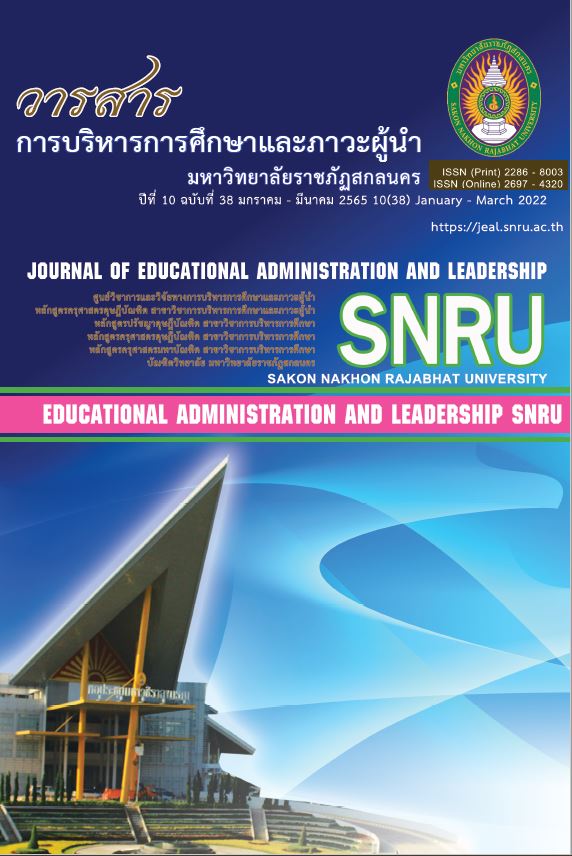

ภาวะผู้นำของผู้บริหารสถานศึกษาที่ส่งผลต่อการปฏิบัติงานของครูผู้สอนในโรงเรียน สังกัดสำนักงานเขตพื้นที่การศึกษามัธยมศึกษา เขต 22
The Leadership of School Administrators Affecting the Teachers’ Performance under the Secondary Education Service Area Office 22
ผู้แต่ง
สุธิกานต์ บริเอก, วัฒนา สุวรรณไตรย์, ฤทัยทรัพย์ ดอกคำ
Author
Sutikan Boriaek, Watana Suwannatrai, Ruethaisap DokKhom
บทคัดย่อ
การวิจัยครั้งนี้มีความมุ่งหมายเพื่อศึกษา เปรียบเทียบภาวะผู้นำของผู้บริหารสถานศึกษา และการปฏิบัติงานของครูผู้สอน ตามความคิดเห็นของผู้บริหารถานศึกษา และครูผู้สอน หาความสัมพันธ์ หาอำนาจพยากรณ์ และแนวทางยกระดับภาวะผู้นำของผู้บริหารสถานศึกษา ที่ส่งผลต่อการปฏิบัติงานของครูผู้สอนในโรงเรียน สังกัดสำนักงานเขตพื้นที่การศึกษามัธยมศึกษา เขต 22 กลุ่มตัวอย่างที่ใช้ในการวิจัย คือ ผู้บริหารสถานศึกษา และครูผู้สอน ปีการศึกษา 2562 จำนวน 348 คน ใช้วิธีการสุ่มแบบหลายขั้นตอน (Multi-Stage Random Sampling) เครื่องมือที่ใช้ในการเก็บรวบรวมข้อมูลครั้งนี้เป็นแบบสอบถามแบบมาตราส่วนประมาณค่า 5 ระดับ ด้านภาวะผู้นำของผู้บริหารสถานศึกษา มีค่าอำนาจจำแนก ระหว่าง .268 – .918 ค่าความเชื่อมั่น เท่ากับ .9797 และด้านการปฏิบัติงานของครูผู้สอน มีค่าอำนาจจำแนก ระหว่าง .337 – .914 ค่าความเชื่อมั่น เท่ากับ .9770 สถิติที่ใช้ในการวิเคราะห์ข้อมูล ได้แก่ ร้อยละ ค่าเฉลี่ย ส่วนเบี่ยงเบนมาตรฐาน ทดสอบสมมติฐานโดยใช้การวิเคราะห์ความแปรปรวนทางเดียว (One–Way ANOVA) การทดสอบ t-test ชนิด Independent Samples การวิเคราะห์หาค่าสัมประสิทธิ์สหสัมพันธ์ของเพียร์สัน (Pearson’s product-moment correlation efficient) และการวิเคราะห์การถดถอยพหุคูณทีละขั้นตอน (Stepwise Multiple Regression Analysis)
ผลการวิจัย พบว่า
1. ภาวะผู้นำของผู้บริหารสถานศึกษา ตามความคิดเห็นของผู้บริหารสถานศึกษา และครูผู้สอน โดยรวมอยู่ในระดับมาก
2. การปฏิบัติงานของครูผู้สอนในโรงเรียน ตามความคิดเห็นของผู้บริหารสถานศึกษาและครูผู้สอนโดยรวมอยู่ในระดับมาก
3. ภาวะผู้นำของผู้บริหารสถานศึกษา ตามความคิดเห็นของผู้บริหารสถานศึกษาและครูผู้สอน จำแนกตามสถานภาพการดำรงตำแหน่ง จังหวัดที่ตั้งสถานศึกษา ประสบการณ์การทำงาน และขนาดของสถานศึกษาโดยรวมไม่แตกต่างกัน
4. การปฏิบัติงานของครูผู้สอนในโรงเรียน ตามความคิดเห็นของผู้บริหารสถานศึกษาและครูผู้สอนจำแนกตามสถานภาพการดำรงตำแหน่ง จังหวัดที่ตั้งสถานศึกษา ประสบการณ์การทำงาน และขนาดของสถานศึกษาโดยรวมไม่แตกต่างกัน
5. ภาวะผู้นำของผู้บริหารสถานศึกษากับการปฏิบัติงานของครูผู้สอนโดยรวม มีความสัมพันธ์กันในทางบวก อย่างมีนัยสำคัญทางสถิติที่ระดับ .01 ในระดับค่อนข้างสูง
6. ภาวะผู้นำของผู้บริหารสถานศึกษามีอำนาจพยากรณ์การปฏิบัติงาน ของครูผู้สอน คือ ภาวะผู้นำการเปลี่ยนแปลง และภาวะผู้นำทางเทคโนโลยีสารสนเทศ โดยรวมอย่างมีนัยสำคัญทางสถิติที่ระดับ .01
7. การวิจัยครั้งนี้ผู้วิจัยได้เสนอแนวทางยกระดับภาวะผู้นำของผู้บริหารสถานศึกษาในโรงเรียนสังกัดสำนักงานเขตพื้นที่การศึกษามัธยมศึกษา เขต 22 ดังนี้ 1) ด้านภาวะผู้นำการเปลี่ยนแปลง ผู้บริหารสถานศึกษาควรมีวิสัยทัศน์ อุดมการณ์ มุ่งมั่น ตั้งใจ มีความคิดริเริ่มสร้างสรรค์ สร้างค่านิยมที่ดี สร้างเชื่อมั่น ความศรัทธา ให้ขวัญกำลังใจ ให้ความสนใจ ชื่นชม ยกย่อง ชมเชยแก่ผู้ร่วมงาน สร้างความตระหนัก ความเข้าใจ เจตคติที่ดี แสวงหาความรู้ มีคุณธรรม จริยธรรม ให้คำปรึกษา ส่งเสริม สนับสนุนให้ครูผู้สอนนำเทคนิควิธีการสอน นวัตกรรมใหม่ ๆ มาใช้สร้างแรงจูงใจ เป็นแบบอย่างในการปฏิบัติงานส่งเสริมให้ครูผู้สอนได้พัฒนาตนเอง มอบหมายงานให้ตรงกับความสามารถของบุคลากรแต่ละคน และปฏิบัติต่อบุคลากรอย่างเท่าเทียมกัน 2) ด้านภาวะผู้นำทางเทคโนโลยีสารสนเทศ ผู้บริหารสถานศึกษา มีวิสัยทัศน์ในการวางแผนการบริหารจัดการ กำกับ ติดตาม ประเมินผลการนำเทคโนโลยีสารสนเทศ ไปใช้ในสถานศึกษา พัฒนาตนเองและเป็นแบบอย่างให้แก่บุคลากร สนับสนุนให้บุคลากรได้พัฒนาตนเอง ให้ทันต่อการเปลี่ยนแปลงของเทคโนโลยีอย่างต่อเนื่อง สนับสนุนการใช้เทคโนโลยี มาใช้ในการปฏิบัติงานและจัดการเรียนการสอน สร้างความตระหนักและความสำคัญของกฎ ระเบียบ และจริยธรรมทางเทคโนโลยีสารสนเทศ ที่ถูกต้องดีงามเหมาะสม
Abstract
The purposes of this research were to examine, compare leadership of school administrators and teacher performance as perceived by school administrators and teachers, determine the predictive power, and establish guidelines to improve the level of leadership of school administrators affecting teacher performance in schools under the Secondary Educational Service Area Office 22. The samples, obtained through multi-stage random sampling, consisted of 348 participants, including school administrators and teachers in the academic year 2019. The instrument for data collection was a set of 5-rating scale questionnaires concentrating on school administrators’ leadership with the predictive power between .268 and .918 and the reliability of .9797, and teacher performance with the discriminative power between .337 and .924, with the reliability of .9770. Data were analyzed through percentage, mean, and standard deviation. The hypothesis testing employed One-Way ANOVA, t–test for Independent Samples, Pearson’s product-moment correlation coefficient, and Stepwise multiple regression analysis.
The findings were as follows:
1. The leadership of school administrators as perceived by participants, as a whole was at a high level.
2. The teacher performance in schools as perceived by participants, as a whole was at a high level.
3. The leadership of school administrators as perceived by participants, classified by positions, provinces of school location, work experiences, and school sizes, as a whole, was not different.
4. The teacher performance as perceived by participants, classified by positions, provinces of school location, work experiences and school sizes, as a whole was not different.
5. The leadership of school administrators and the teacher performance as perceived by participants, had a positive relationship at the .01 level of significance.
6. The leadership of school administrators which had the predictive power toward the teacher performance at the .01 level of significance overall. consisted of transformational leadership and Information technology leadership,
7. The researcher proposed the guidelines for improving leadership of school administrators in schools under the Secondary Educational Service Area Office 22 as follows: 1) Transformational leadership. This included having vision, ideology, commitment, initiative and creativity, and building good values, confidence and faith, stimulating morale and interest, displaying admiration and appraisal among colleagues, creating awareness, understanding, and good attitude, seeking knowledge, having morality and ethics, providing counseling, encouraging teachers to apply innovative teaching techniques, creating motivation, being a role model in task performance, encouraging teachers for self-development, assigning tasks to match with individual capabilities, and treating personnel equitably; and 2) Information Technology Leadership; School administrators should have a vision in terms of management planning, monitoring, and evaluating the implementation of information technology into educational institutions. School administrators should also develop themselves and be a role model for others, support personnel self-development to keep pace with the changes of technology on a regular basis, supporting the use of technology in performing tasks and teaching and learning management, raising awareness and importance of rules, regulations, and ethical use of information technology
คำสำคัญ
ภาวะผู้นำของผู้บริหารสถานศึกษา, การปฏิบัติงานของครูผู้สอนKeyword
The Leadership of School Administrators, The Teachers’ PerformanceNotice: Undefined variable: dataSet in /var/www/html/ArticleView.php on line 116
Notice: Trying to access array offset on value of type null in /var/www/html/ArticleView.php on line 116
บทความทุกบทความเป็นลิขสิทธิ์ของ
Notice: Undefined variable: dataSet in /var/www/html/ArticleView.php on line 116
Notice: Trying to access array offset on value of type null in /var/www/html/ArticleView.php on line 116
เท่านั้น
กำลังออนไลน์: 15
วันนี้: 942
เมื่อวานนี้: 1,708
จำนวนครั้งการเข้าชม: 1,181,875
อาคารบัณฑิตวิทยาลัย ชั้น 2 ตำบลธาตุเชิงชุม อำเภอเมือง จังหวัดสกลนคร 47000
โทร/
แฟกซ์ 0-4297-0093
บรรณาธิการ: รองศาสตราจารย์ ดร.ไชยา ภาวะบุตร
ติดต่อ/สอบถาม: นายธีรเวทย์ เพียรธัญญกรณ์
โทร: 0-4297-0093